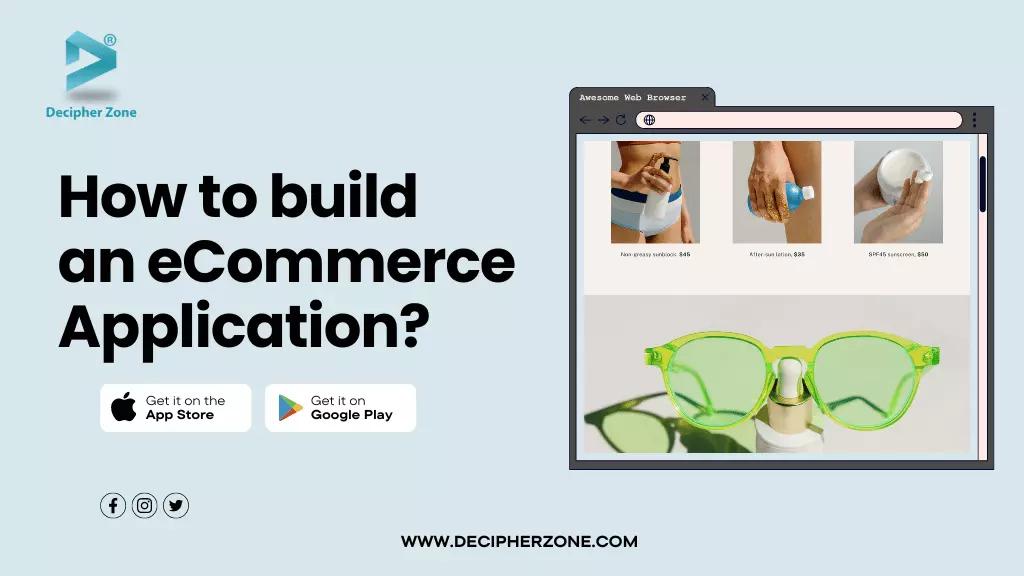Adaptability to current trends and technologies can help in upscaling the business. To learn all about building an eCommerce application go through the following article. This can clear your doubts as it includes all the potential points like the definition of eCommerce, future trends, current updates, features, technologies, UI/ UX design, and development process for eCommerce apps.
Businesses that fail to adapt, risk being left behind. Considering the current technical evolution, consumers have made online shopping a habit that has significantly impacted the e-commerce industry.
Suppose, you want a watch, will you check it first out on your phone or laptop or do you wish to visit the stores? Buying a watch online can save you time by offering a variety of options and eliminating the need to visit multiple stores to compare prices.
How to Develop an eCommerce Application: Step-by-Step Guide
Thus, creating an eCommerce application can result in increased customer reach, higher conversion rates, and improved usability. Are you interested in starting a business with a low budget Or Are you looking to expand your business online? eCommerce industry is the ideal choice. You can get all the answers to your questions here. Build your own online store at little to no cost. To gain further knowledge continue reading.
Your Learning Journey:
-
Understanding what eCommerce apps are,
-
What is the importance of eCommerce applications in the current global market,
-
What are the future trends to consider in the process of developing eCommerce applications,
-
How to choose the right technology for eCommerce applications,
-
How do you choose between custom development and e-commerce platforms suitable for your business,
-
How to design your eCommerce application,
-
What features to include in the eCommerce apps,
-
What are the steps to develop an eCommerce application?
Introduction to eCommerce Applications
eCommerce is an online shopping store that includes trading of goods and services. Imagine having a virtual shopping mall right at your fingertips. You can directly access anything you want that is trending or is your need.
Basically, these apps make it easier to shop while staying in your bed. You can browse, review, compare, select, and buy items with just a few clicks and it will be delivered to your doorstep.
On these applications, users can view product details, and items selected in a cart or a wishlist, and complete secure payment from anywhere in the world. There is no need to visit a physical store, you can simply browse on a computer, laptop, or mobile phone, and purchase items from anywhere in the world with an internet connection.
Current Value of eCommerce Applications in the Market
The eCommerce industry has become increasingly a necessary part of consumers' everyday lives, influencing the way people shop for essential items and significantly impacting the global retail industry.
Revenue: There was an impressive shift in the previous year, marking an 8.1% increase of $3.88 trillion in 2024. This shows the dependency of users on digital shopping platforms across the globe.
Usage: The usage rate of eCommerce applications has increased over the past few years, with COVID-19 acting as a catalyst. Users increasingly turn to downloading online platforms for convenience, expanding the growth in both user engagement and application downloads.
Growth: The eCommerce industry is expected to maintain strong momentum from 2024 through 2030, signaling a robust future for businesses that invest in digital platforms.
These figures demonstrate the undeniable influence and potential growth of eCommerce applications in today’s economy.
Future Trends in the eCommerce Industry
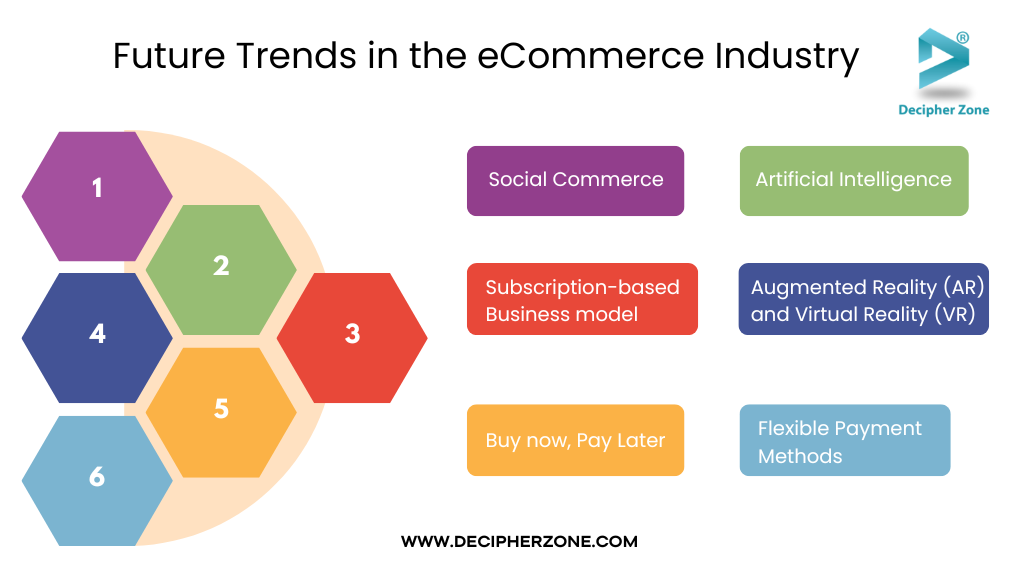
Where trends have taken years to develop in the days of brick and mortar, which now take months, the industry has been propelled into emerging and intriguing areas by the rapid pace of innovation in the field. To stay competitive businesses need to keep updating with adapting the modern technologies. Below, you will find some of the emerging trends,
1. Social Commerce
Businesses can use social media platforms like Instagram, Pinterest, and Facebook to attract consumers. By creating innovative eye-catching shoppable posts and ads, companies can sell their products. Users can explore and simply place an order without even leaving the respective application.
2. Artificial Intelligence
Artificial Intelligence (AI) is transforming the eCommerce industry by increasing the customer experience, and sales and optimizing purchasing and selling operations. Basically, AI shows recommended products to the users by collecting the data of their browsing habits and purchasing history and personalizing the shopping experience.
3. AI Chatbots
AI-powered Chatbots are designed to help businesses ease the burden by providing around-the-clock customer support. These chatbots are capable of managing basic queries independently and even complex ones with the help of memory updation or machine learning. But at times even the chatbots fail to respond. For further processing, they are instructed to transfer complex and complicated conversations and inquiries to the human support agents who are available.
4. Subscription-based Business Model
Businesses can adopt a subscription-based model to provide a premium experience to a specific audience which can increase customer loyalty and generate recurring income. Platforms like Netflix, Amazon Prime Video, Spotify, etc charge to provide exclusive services including content, discounts, and personalized experience to those customers who subscribe to the ‘Premium plan’.
This subscription model can help you gather useful insights into customers’ preferences and behavior to improve the product offerings, and discounts and implement tailored marketing strategies to the individual users.
For example, a fitness platform offers monthly subscription plans that provide personalized workout routines and nutrition guidance based on the user’s fitness goals and progress. This approach delivers a customized fitness experience for the customer while securing a consistent source of revenue for the platform.
5. Augmented Reality (AR) and Virtual Reality (VR)
Augmented Reality (AR) and Virtual Reality (VR) technologies can provide a 3D experience to the users to provide a real-time shopping experience from comfortably sitting on a sofa at home or anywhere in the world with an internet connection.
For example, while shopping for furniture. You can select items like sofas, tables, or chairs and place them within your living space using your smartphone or tablet. By simply pointing the camera at the room or living room, you can see how different pieces of furniture match your walls and would look in real time.
This immersive experience will help users visualize the final setup before purchasing. And once the user is satisfied with the specific product they can place an order. This visual interaction with the products can be a real reason for the boost in sales.
6. Buy now, Pay Later
Buy Now, Pay Later (BNPL) technology relies on a refined infrastructure to offer smooth payment experiences. It manages transaction processes, detects fraud, and uses credit scoring algorithms to reduce risks for both parties involved. With the help of this technology trend users can purchase items and pay in installments with little to no interest.
BNPL is an alternative to traditional credit cards, providing more flexibility, low cost, and long-term debts. This technology works better in both ways, B2B and B2C sectors, offering the ability to manage cash flow efficiently when making large payments and avoiding large amounts of credits.
7. Flexible Payment Methods
Adding a variety of payment options is essential for boosting conversion rates, and with the help of third-party microservices, retailers can easily integrate alternative payment methods including cryptocurrency and mobile wallets like Apple Pay, PhonePe, and Google Pay. The data collected through these payment methods can be used to offer personalized experiences and targeted promotions based on their preferences.
Businesses can also integrate approaches like blending online and in-store shopping, Buy Online, Pick Up In Store (BOPIS). This allows customers to purchase items online and pick them up from the physical store, allowing the customers to save time and shipping charges.
The ability to accommodate various payment methods and strategies like Buy Online, Pick Up In Store (BOPIS), or Buy Now, Pay Later (BNPL) to attract a wide range of customer base, improve customer satisfaction, and thrive in a competitive environment.
Choosing Between Custom Development vs. eCommerce Platforms (e.g., Shopify, WooCommerce)
When developing an eCommerce application, the first question to consider is whether to opt for custom eCommerce development or off-the-shelf eCommerce platforms. Well, you can only choose the ideal development option that suits your business needs. To determine the suitability of application development, let’s start by learning about it.
Custom E-commerce Development
Custom eCommerce Development refers to the process of building a tailored online shopping platform from scratch, specifically designed to meet the unique needs and requirements of a business. This approach provides a high level of customization, which is time-consuming and can be expensive depending on the complexity of the application.
Custom e-commerce development solution effectively allows the integration with third-party tools and services like CRM (Customer Relationship Management) systems, ERP (Enterprise Resource Planning) systems, payment gateways, and marketing automation platforms.
These Includes
-
Specific to the Requirements: A custom e-commerce development approach allows you to build exactly what is required for your business, without any unnecessary third-party features or external dependencies as every element of the application is curated to specific needs that provide efficiency to the designed solution.
-
Compatible Development: custom e-commerce development allows you to be flexible to meet new requirements. You can modify, expand, or upgrade the platform adapting to new trends in the market whenever your business requires.
-
Control and Ownership: The rights to use and modify the application are exclusively reserved to the owner. The developer cannot alter or distribute any of the software without the customer’s permission. Any bugs or issues identified can be promptly addressed by the development team, ensuring the system runs smoothly and securely. The nature of the solution is customized, making it unique and competitive.
Pros
-
Ideally tailored to the business needs,
-
Evolve business with the platform,
-
Uniqueness of the application reflects the brand identity,
-
Faster Adaptation to market changes.
Cons
-
High development costs,
-
Time consuming,
-
Never-ending maintenance,
-
Dependency on developers,
Off-the-Shelf E-commerce Platforms
Off-the-shelf eCommerce Platforms are pre-built platforms that allow businesses to design and construct online stores and shopping websites. These frameworks come equipped with all the essential infrastructure, tools, and features necessary to create, manage, and optimize online shopping experiences.
With the help of these tools or frameworks, businesses can save time and resources and focus on improving user experience and other functionality. This approach not only accelerates the development process but also ensures that best practices in e-commerce are incorporated from the outset.
These Includes
-
Product Management: Product management is a built-in tool that allows to efficiently handle product inventory. With the ability to easily add, edit, categorize, and search for products, to keep the catalog always up-to-date and organized.
-
Content Management System: A content management system is a feature that allows businesses to edit and publish both static and dynamic content pages on their websites. This reflects the online professional presence of the company.
-
Marketing Tools: Marketing tools provide flexibility to create promotional activities like setting up discounts, coupons, and special offers based on customer behavior, product categories, or seasonal trends which helps businesses to attract users and increase sales.
-
User and Role Management: User and role management feature allows business users including customers, administrators, and content managers to access the platform based on their specific roles and permissions. This platform provides functionality related to registering, authenticating, and authorizing users while offering vigorous role support.
Pros
-
Low initial cost,
-
Quick setup,
-
Pre-built features,
-
Regular updates,
-
Third-party integration support,
-
Fast access to new features.
Cons
-
Limited customization,
-
Scalability issues,
-
Ongoing costs,
-
Common design,
-
Feature bloat,
-
Limited SEO Flexibility.
10 Trending eCommerce Platforms
-
WooCommerce,
-
Shopify,
-
Adobe Commerce,
-
BigCommerce,
-
OpenCart,
-
Appy Pie AI Website Builder,
-
Squarespace,
-
Weebly,
-
Wix,
-
3dcart,
Developing Core Features in an eCommerce Application
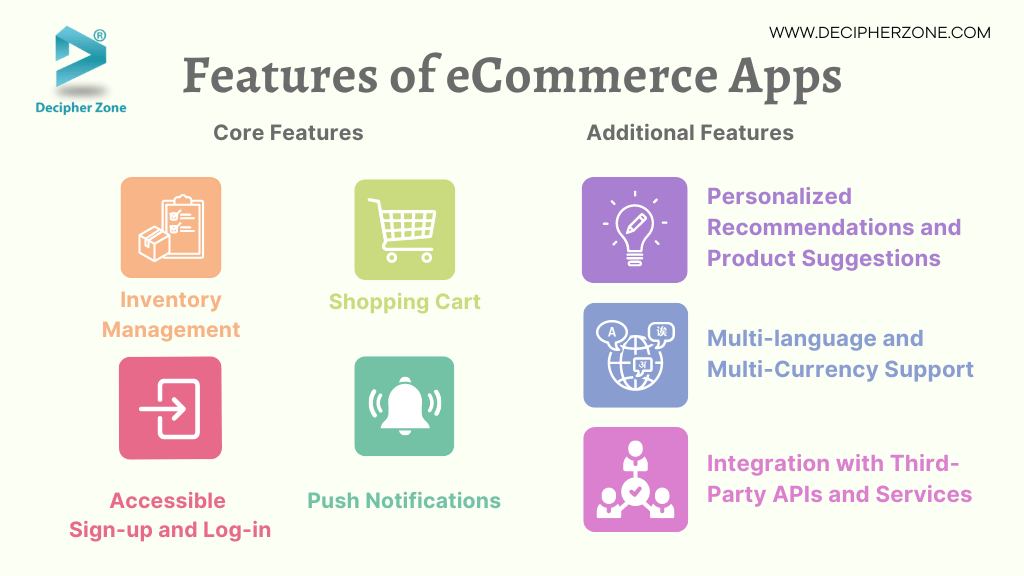
To develop an eCommerce application, there are certain features that are a must to include in an application for seamless and effective operations, which are listed below:
1. Accessible Sign-up and Log-in
Easy sign-up and log-in help improve user experience and conversion rates. You can simplify lengthy and complicated registration forms by allowing users to log in using external accounts like Apple, Google, or social platforms. This not only saves time and effort but also encourages more users to sign up.
2. Inventory Management
This feature provides accurate stock updates, which makes it easier for the users to place an order and avoid disappointment if the product is sold out after an order is placed. This feature allows users to view and track product availability and avoid issues like overselling or backorders. These records contribute to operational efficiency by allowing businesses to track the stock level optimize the supply chains and smooth fulfillment processes.
3. Push Notifications
This feature is totally for the benefit of the businesses as they can stay connected with the customers in real time. By sending push notifications to update users on the latest information like ongoing sales, personalized discounts, and reminders for items in their wish list, keeping them engaged and encouraging purchases. From the point of view of users/ customers, this feature sends updates to users on delivery status, leading customers to be informed about their orders every step of the way.
4. Shopping Cart
This feature allows users to organize their purchases seamlessly. Users can add the products they are interested in, compare prices, and review product details like images, and brief descriptions before purchasing it. This takes the shopping experience to the next level by offering the flexibility to temporarily store items, adjust quantities, apply discounts or coupons, and remove unwanted items.
5. Additional Features
-
Personalized Recommendations and Product Suggestions: This feature allows them to use customer data and purchasing history to provide personalized product recommendations to drive sales. The analysis of customer data involves past purchases, viewed items, and search history, the application can suggest relevant products, increasing the likelihood of conversion. Implementing machine learning algorithms can be a suggestion to recommend products the user has frequently searched for.
-
Multi-language and Multi-Currency Support: This feature helps your business to cater to the global audience, by offering various languages, and multiple currencies to create a more comfortable shopping experience. For example, a customer in Europe can view the application in German and make purchases in Euros. This not only broadens the customer base but also improves customer trust, the users are more likely to engage with a platform that understands their local preferences and financial services.
-
Integration with Third-Party APIs and Services: With the help of third-party payment gateways like PayPal, Stripe, or Square and shipping services like UPS, FedEx, or DHL and content relationship management (CRM) tools like Salesforce or HubSpot can help your business streamline processes, allowing smoother transactions, order fulfillment, and improved customer services. By integrating multiple payment options, customers experience both convenience and security, resulting in a more satisfying user experience.
Choosing the Right Tech Stack For eCommerce Application
Choosing the right tech stack for your eCommerce app requires critical thinking and appropriate decision-making tailored to your business needs while keeping everything secondary.
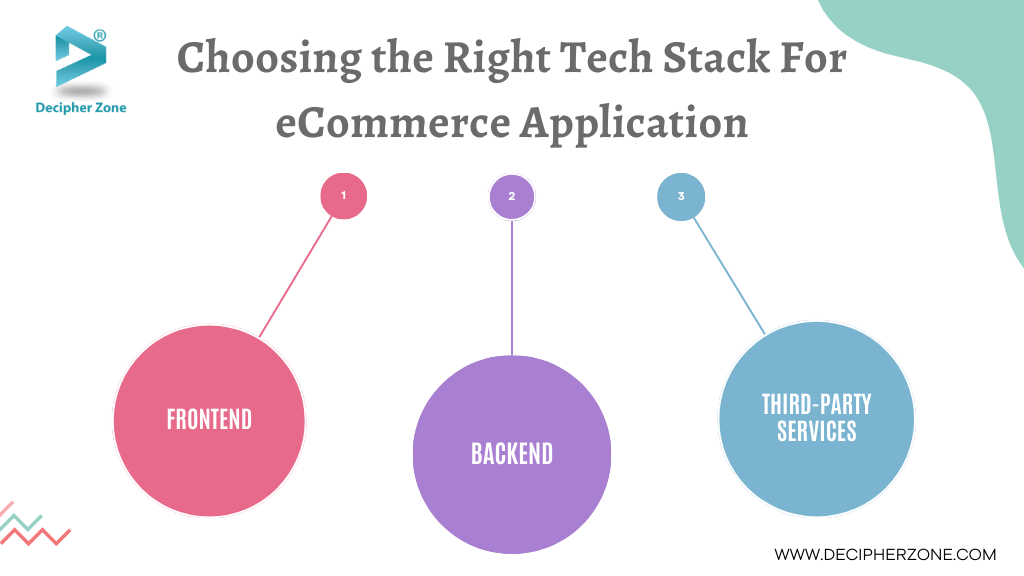
You need to have basic knowledge, if you are new to eCommerce application development. The eCommerce application consists of Frontend and Backend, where frontend or client-side is everything you see and interact with on the application through your tablets, mobile devices, or laptops/desktops, and backend or server-side is where all the back operations are managed.
Read this detailed guide to further learn about the frontend and backend frameworks and technologies.
Third-Party Services
By integrating specialized tools and services can enhance the overall performance of your eCommerce application. These external solutions keep the application agile and scalable, adapting to changing market needs and preferences without the need for extensive in-house resources. Some of these tools and services are,
-
Analytics Tools: Tools like Google Analytics, Hotjar, and Mixpanel enable detailed reporting and real-time data visualization, helping merchants identify areas for improvement and measure the effectiveness of marketing campaigns. This data-driven approach provides insights into customer behavior, sales trends, and application performance, leading to user engagement and increased sales.
-
CRM: CRM systems like Salesforce, HubSpot, or Zoho, allow businesses to manage customer relationships more effectively, including tracking user interactions across multiple channels, managing leads, and delivering personalized marketing communications.
-
Payment Gateway: Payment gateway services such as PayPal enable users to seamlessly and securely make purchases through your application using multiple payment options. Businesses can facilitate online transactions by processing credit cards, digital wallets, etc. These multiple payment options not only provide security but also improve conversion rates by catering to customer preferences.
-
Shipping Modules: By integrating logistics services like UPS, FedEx, or DHL, businesses can streamline order processing efficiently and manage shipping options, calculate costs, and track shipping. Also, shipping costs, delivery estimates, and tracking information can be shared directly with customers which increases transparency and improves customer satisfaction.
UI/ UX Designing for Your eCommerce Apps
A well-designed user interface (UI)/ user experience (UX) design is crucial to driving customer satisfaction, enhancing usability, and increasing conversion rates. To provide the most enjoyable experience for your eCommerce app, create your now. Read this blog to explore UI/UX design and all about it.
Steps to Develop an eCommerce Application
When it comes to learning how to construct an eCommerce application, there are 7 essential steps. These steps will guide you through the phases of building an eCommerce app, whether you're working independently or with a team.
Step 1- Research & Set your goals
Step 2- Choose the most suitable platform
Step 3- Define the core features
Step 4- Create UI/UX design
Step 5- Testing
Step 6- Publish
Step 7- Maintenance
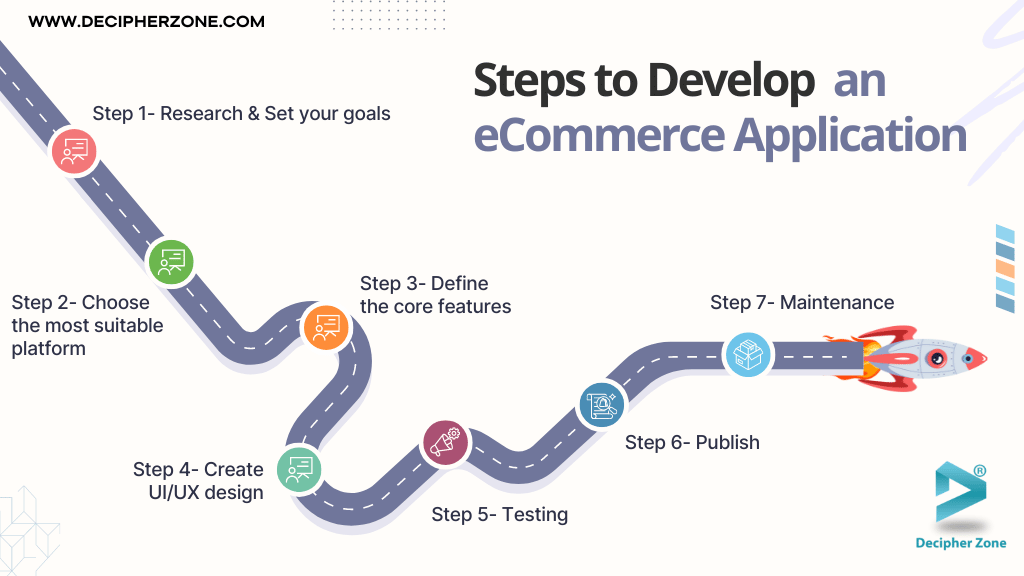
The basic process of development of web applications and mobile apps are somewhat similar. The only difference is the customization which is tailored to the business requirements and needs.
Explore the detailed guide to web application development and mobile application development.
Closing Thoughts
Building an attractive, eye-catching, and innovative eCommerce application isn’t complex yet requires the experts either you create yourself or with a team. Decipher Zone offers proficient web and mobile app developers to develop excellent solutions. With years of experience, they can even recommend or guide you to create an intuitive eCommerce application. If interested, contact us by submitting your application through the chat box, or by sending an email.
People May Ask
1. How much does it cost to make an eCommerce application?
The cost varies considering the complexity of the application, but the can be anywhere between $8,000 to $6,00,000.
2. Can I build an eCommerce website on my own?
When it comes to creating an eCommerce app, you have the option to either develop it independently or opt for a customized eCommerce application. However, entrusting the task to skilled and knowledgeable professionals is highly recommended.
3. How long does it take to build an e-commerce app?
The duration of building an eCommerce application is approximately 4-12 months or maybe more depending on the factors like complexity of the app, features and functionality, technology stack, team size, and more.

